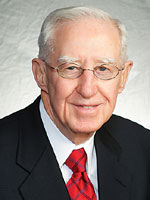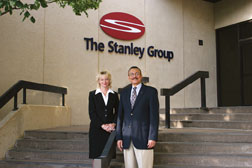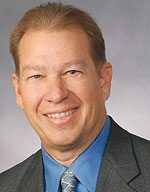... offers remaining managers more financial flexibility and has allowed the firm “to remain in the hands of the people who helped [Anderson] build it,” he adds. While the founder’s son is among its new owner-executives, “he is treated like any other employee, not as a prince,” says Shaw. “So we didn’t have the nepotism that often ruins” a family-owned firm, he adds.
These days, market forces are shaping how firms develop their next-generation leaders, with clients, competitors and CEOs themselves adding new pressures. WGI was quick to note its inclusion among the top 20 North American firms “for leaders,” as ranked last month in a biennial survey by Fortune magazine and two human-resources consulting firms. The contractor also was ranked in 2005. “Our industrial customers look at our awards for how we develop our talent and see it as a huge positive,” notes Hanks, who says the firm’s leadership approach was a key factor in attracting to URS Corp., now finalizing an acquisition deal.

|
| RICHARD L. SHAW |
Other executives agree that deeper client interest in management succession is prompting more firms to formalize planning. “They are asking us about our succession strategy before they select us,” says Pete Hannan, senior director of human resources at CH2M Hill Cos. and executive director of Construction Personnel Executives Group, an ad hoc group of about 40 $1-billion-plus contractors and design-builders that meets twice a year. “It’s the front-and-center topic for every firm in the business now. But how do we keep it on the front burner when people are so busy?”
One key approach is to tie succession planning to compensation, a strategy many firms are now adopting. Says WGI’s Hanks, “I will not consider someone for advancement unless they have identified their own successor.”
Companies are also setting up corporate structures akin to small fiefdoms that foster entrepreneurship and broad responsibility for potential successors. “We have six divisions, and each has a president,” says Uhler. “We did it on purpose.” Kiewit’s 22 district managers are “autonomous leaders responsible for every aspect of planning,” says Chapman. Managers are encouraged to improve not just contracting skills but techniques in business development, technology and owner relations, he adds. “We start the process almost immediately,” says Chapman.
 The Stanley Group Leadership transfer process from Stanley’s Thomopoulos (right) to Roberts is only the beginning.
|
At Stanley Consultants, the management succession process was broadened from what it was 20 years ago when the choice was only between the obvious contenders: the operations and project management division chiefs, says CEO Gregs Thomopoulous.
This time, candidates could nominate themselves and were asked to present to board members a 45-minute-long “vision” for the $192.4-million company’s future and how it would be achieved. Not surprisingly for a company ahead of tradition in having a minority CEO, his successor is Gayle Roberts, a 25-year company veteran who was senior vice president in charge of its health-care and education division. Roberts is already planning for her successor. “About 50% of our officers are 58 years old or older,” she says. “It’s time to start looking.”
The industry’s global development will further change its complexion. Uhler notes that between 25% to 35% of its second-generation management contenders are not U.S.-based. “We’re convinced that accents sell, but we try to affiliate them with our company, not their nationality,” he says. “We try to develop them into internationalists.”
Firms also are moving to perfect their ability to scout talent and expand it through the ranks. Caterpillar’s decade-old Talent Management System, which now covers about half of its 96,000 workforce, was recently rolled out to include production employees, says Arvin. “We didn’t have a formalized leadership model in the company before 2001,” he says. Efforts are now under way to expand it to 2,500 mid-level managers, Arvin adds.
The company was also ranked among the top 20 North American leadership firms on the 2007 Fortune list but has yet to promote the accolade. “We applied for the award because we want to get better,” says Arvin, noting that the firm was disappointed not to make the list of top 20 global firms for leadership. “We still have a long way to go,” he claims.
Other well-managed and successful industry firms also admit succession planning mistakes. “Over the years, we’ve lost candidates because they thought they didn’t have a future here,” says Tony Franceschini, CEO of engineering firm Stantec Inc., and Edmonton, Alberta. “We didn’t communicate that well. We’re improving.” He emphasizes that management succession plans “don’t work 100% of the time, but their chances of success go up because it’s identifiable.” Franceschini has identified the end of 2008 as his own likely date to step down. But as is common for today’s active industry leader, “it could be later.”
Kleinfelder’s Salontai, 52, CEO since 1997, has made his succession plan more clear-cut. “I’m the third CEO, and all have retired before 50,” he says. “The sooner you announce, everyone knows there’s a plan.” Three top executives are already identified to take Salontai’s place and are now being formally groomed. “They all have unique projects to do,” including the selection of a “large” acquisition target in the southeastern U.S. for the San Diego-based firm, he says. “They have to convince everyone of the strategic opportunity, make the purchase and integrate it,” says Salontai.

|
| GERALD SALONTAI |
Management succession planning has become a new growth market for outside consultants and executive-training providers. “Companies struggle with assessment tools,” says Denise Howe, Kleinfelder’s human-resources director. “We have to have someone who can help us pick the right ones.” The firm formalized its management succession approach in 2005 after implementing its last strategic plan. Work on the next one is set to start in February.
Professional coaching is becoming de rigueur in more industry firms. “Each of Kitchell’s top 22 executives has an outside coach, hired at about $300 an hour for sessions every two to four weeks,” says Schubert. “More than 100 of our 700 employees have attended a coaching class.”
The firm spends about $200,000 a year on coaching but that has helped drop annual turnover from 27% to 19% overall and to 4% among younger staffers who are being coached by senior employees, Schubert says. Non-supervisory mentors are used to help developing managers on “stretch assignments,” says Hanks. “That takes the intimidation factor out of the equation,” he says. Franceschini notes that there are not enough mentors in his firm to satisfy those who want the link. “We can only do about 10 to 12 mentor relationships a year now. Demand is for 40 to 50,” he says.
|
"This is no different than contracting [for construction] projects." —Gerald Salontai, Ceo, The Kleinfelder Group
|
Mentoring and coaching will have the added benefit of keeping aging baby boomers from “disengaging” if they’re not ready for full-time leisure. “The day of not working is not the model we expect from retirees in the future,” Hanks says.
Observers already see a trend to inject more financial discipline into industry management, so that an owner’s or CEO’s relatives and longtime cronies are not the predictable successors if they lack critical skills. “You need someone who has that entrepreneurial spark, not just someone who’s been doing the owner’s bidding for 30 years,” says FMI’s Rice. Management experts already see growing evidence of such changes in firms that have taken on more private-equity investment. “This will drive stronger boards of directors,” says Paul Zofnass, presi-dent of EFCG Inc., a New York City consultant. “There is increasing sophistication.”
But today’s bosses are ultimately responsible for fostering succession. “There’s a lot of things you start as a leader that you can’t finish,” says Franceschini. “You have to accept that you may not be there to accept the congratulations.”

Post a comment to this article
Report Abusive Comment